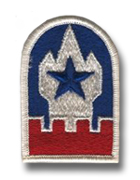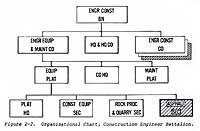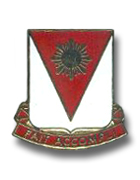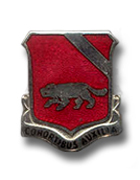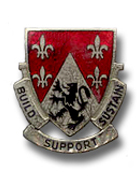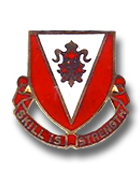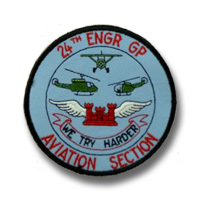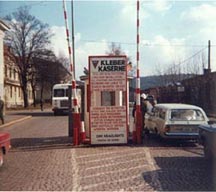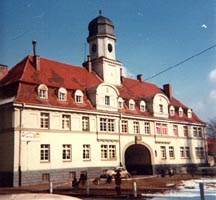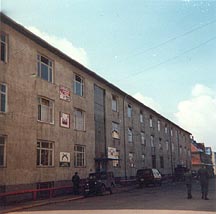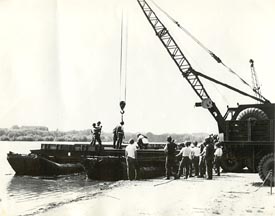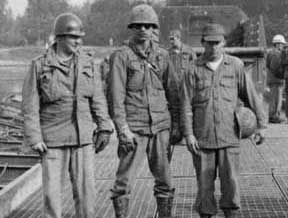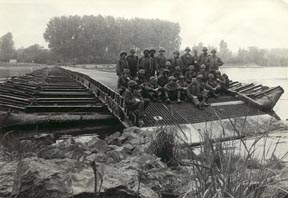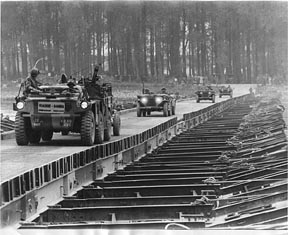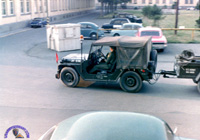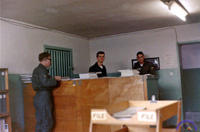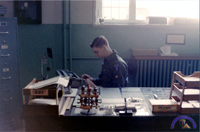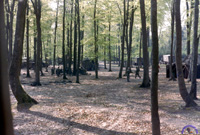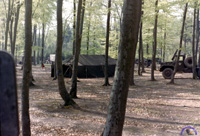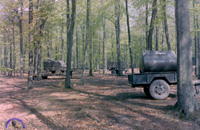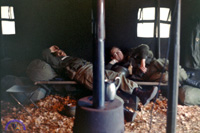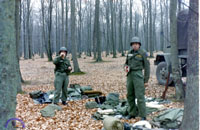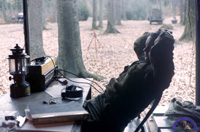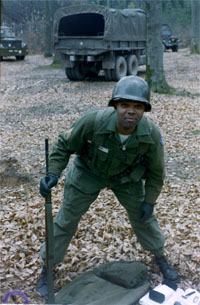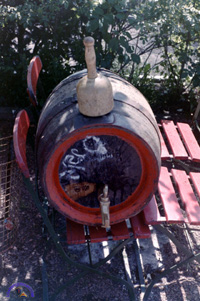| If you do
NOT see the Table of Contents frame to the left of this page, then
Click here to open 'USArmyGermany' frameset |
||||||||||||||||||||||||||||||||||||||||||||||||||||||||||||||||||||||||
|
24th
Engineer Group (Const) |
||||||||||||||||||||||||||||||||||||||||||||||||||||||||||||||||||||||||
|
|
||||||||||||||||||||||||||||||||||||||||||||||||||||||||||||||||||||||||
|
||||||||||||||||||||||||||||||||||||||||||||||||||||||||||||||||||||||||
|
|
||||||||||||||||||||||||||||||||||||||||||||||||||||||||||||||||||||||||
| 311th Engineer Construction Group | ||||||||||||||||||||||||||||||||||||||||||||||||||||||||||||||||||||||||
| 1952 | ||||||||||||||||||||||||||||||||||||||||||||||||||||||||||||||||||||||||
| (Source: USAREUR STATION LIST, 15 Dec 1952) | ||||||||||||||||||||||||||||||||||||||||||||||||||||||||||||||||||||||||
| HHC, 311th Engr Const Gp, Kaiserslautern | ||||||||||||||||||||||||||||||||||||||||||||||||||||||||||||||||||||||||
| At this time there were two other Engineer Contruction Groups located in Germany: The Station List also shows six Engineer Const Battalions in Germany in Dec 1952, with one more on the way from the US: |
||||||||||||||||||||||||||||||||||||||||||||||||||||||||||||||||||||||||
| 1954 | ||||||||||||||||||||||||||||||||||||||||||||||||||||||||||||||||||||||||
| (Source: STARS & STRIPES, July 24, 1954) | ||||||||||||||||||||||||||||||||||||||||||||||||||||||||||||||||||||||||
| The 311th Engineer Const Group 1) at Kleber Kaserne, Kaiserslautern, assists the Western Area Command with construction work and has been kept very busy since its arrival in Germany in early 1952. The 311th is comprised of a Hq/Hq company, two engineer construction battalions (45th & 432nd?), three Labor Service construction companies (8361st, 8503rd, 8850th), one Labor Service dump truck company (?), one US dump truck company (795th?) and a heavy equipment company (370th?). The Group is currently drafting plans for its most extensive construction project since arriving in USAREUR. The project, estimated to cost close to $1 million, will include construction of such diverse items as a "cloverleaf" traffic pattern 2) and bleachers for a baseball field. Other construction projects that are included in the plans being drafted are the construction of hospital train stabling areas at the Neubruecke and Muenchweiler hospitals and a solid fuel storage area for the Kaiserslautern Detachment of WACom. |
||||||||||||||||||||||||||||||||||||||||||||||||||||||||||||||||||||||||
| 1) The Group is an Army Reserve unit out of San Antonio, Tx that was activated on September 11, 1950. 2) The "cloverleaf" traffic pattern project will involve major earthmoving work by the 311th in conjunction with the construction, by the German government, of a dual highway through Kaiserslauterm (Route N40). The "cloverleaf" is expected to alleviate a big traffic problem for the city as well the Vogelweh Housing Area. |
||||||||||||||||||||||||||||||||||||||||||||||||||||||||||||||||||||||||
| (Source: STARS & STRIPES, July 24, 1954) | ||||||||||||||||||||||||||||||||||||||||||||||||||||||||||||||||||||||||
| 293rd Engineer Construction Battalion, 311th Engr Const Gp. CO of the battalion is Lt Col Victor J. Reafsnyder; previous CO was Lt Col Thomas B. Hunter. | ||||||||||||||||||||||||||||||||||||||||||||||||||||||||||||||||||||||||
| (Source: STARS & STRIPES, September 15, 1954) | ||||||||||||||||||||||||||||||||||||||||||||||||||||||||||||||||||||||||
| Hoge, Reber, Albrecht dedicate rail project (article) By Robert J. Dunphy, S&S Staff Correspondent 432nd Engineer Construction Battalion, 311th Engr Const Gp, completes a three-mile long rail spur between Kaiserslautern Hauptbahnhof and Panzer Kaserne (three photos). |
||||||||||||||||||||||||||||||||||||||||||||||||||||||||||||||||||||||||
| (Source: STARS & STRIPES, December 28, 1954) | ||||||||||||||||||||||||||||||||||||||||||||||||||||||||||||||||||||||||
| The 311th Engineer Construction Gp, Kaiserslautern, has been redesignated as the 24th Engr Const Gp with no change in mission or station. The 311th, a former US Army Reserve unit located at San Antonio, TX and federalized on Sept 11, 1950, will revert to Reserve status. The 311th Engr Const Gp arrived in Germany in March 1952. |
||||||||||||||||||||||||||||||||||||||||||||||||||||||||||||||||||||||||
| ORGANIZATION (1952): | ||||||||||||||||||||||||||||||||||||||||||||||||||||||||||||||||||||||||
|
||||||||||||||||||||||||||||||||||||||||||||||||||||||||||||||||||||||||
| [1] STATION LIST, 13 June 1952 | ||||||||||||||||||||||||||||||||||||||||||||||||||||||||||||||||||||||||
| The 311th served as the main engineer construction unit within Western Area Command and supervised many large construction projects during its stay in Germany, incl. the Range Tank Trail at Baumholder; earthwork for the Cloverleaf Traffic Pattern at Vogelweh; rifle ranges at Baumholder and Froehnerhof; and hospital sites at Neubruecke and Muenchweiler. | ||||||||||||||||||||||||||||||||||||||||||||||||||||||||||||||||||||||||
| 24th Engineer Construction Group | ||||||||||||||||||||||||||||||||||||||||||||||||||||||||||||||||||||||||
| 1954 - 1972 | ||||||||||||||||||||||||||||||||||||||||||||||||||||||||||||||||||||||||
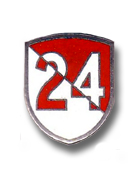 24th Engineer Group DUI
24th Engineer Group DUI |
||||||||||||||||||||||||||||||||||||||||||||||||||||||||||||||||||||||||
| (Source: STARS & STRIPES, Sept 25, 1958) | ||||||||||||||||||||||||||||||||||||||||||||||||||||||||||||||||||||||||
| 'Dirty Mission' Assigned to Unit Playing with dirt may be fun for youngsters, but it is deadly serious business with men of the soil laboratory of the 24th Engr Gp here. One of their jobs Is to crush, crumble, weigh and measure soil, and they do it by every possible method. The lab spends more than 160 man-hours a week testing soil, concrete, and asphalt. Methods such as sieve analysis are used to enable technicians to isolate the components of soil by size, texture, and grade. The soil is passed through a series of screens ranging in size from three inches square to one so fine that light is barely visible through its mesh. At each level a different type of soil, such as silt or gravel, is collected. An unusual machine used by the unit is the "beam-buster," which breaks a concrete beam into cross sections which are examined for small, telltale marks indicating serious weakness. The device also measures the amount of pressure a block can absorb before it cracks. This strength is checked against that called for by job specifications. The lab men also do outdoor testing. In the field they test the shearing strength of the ground -- its ability to support a planned road, bridge or building. One test is the digging of post holes about 12 feet deep from which soil is taken and examined as to structure of layers, moisture content and general consistency. For a new road a post hole is dug approximately every 500 feet. A job typically assigned to the soil lab was that for a Nike missiles site. The weather last December had been alternating between snow and rain, and the soils crew took tests to ascertain if the ground would support the site. The surface was found to be substandard. As a result of the finding, approximately 12 inches of top soil were removed and replaced by stronger earth to provide the solid foundation required by the Nike site. |
||||||||||||||||||||||||||||||||||||||||||||||||||||||||||||||||||||||||
| 1972 - 1973 | ||||||||||||||||||||||||||||||||||||||||||||||||||||||||||||||||||||||||
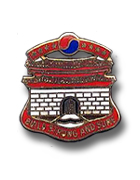 24th Engineer Group DUI (approved Feb 23, 1972)
24th Engineer Group DUI (approved Feb 23, 1972)The 24th Engineer Group (Construction) was reassigned from Korea to USAREUR on 20 December 1954 (less personnel and equipment). The Group was further assigned to the 7th Engineer Brigade on 1 October 1955. On 1 July 1974, with the inactivation of the US Army Engineer Command, Europe, the 24th Engr Gp was reassigned to HQ USAREUR. The Group was located at Kleber Kaserne, Kaiserslautern. |
||||||||||||||||||||||||||||||||||||||||||||||||||||||||||||||||||||||||
| (Source: Significant Events, 24th Engineer Group (Construction), APO 09227, USAENGCOMEUR, 1973) | ||||||||||||||||||||||||||||||||||||||||||||||||||||||||||||||||||||||||
| In January 1971,
the 39th Engineer Gp (Const) and one
construction company from (each of) its two member battalions, the
79th and 94th Engineer Battalions (Const), were inactivated. The Asphalt
Section of the Engineer Equipment and Maintenance Company (A Company)
of these battalions was also eliminated. These battalions were then
assigned to the 24th Engineer Group (Const). INTRODUCTION The 24th Engineer Group (Construction) is the US troop construction element of the US Army Engineer Command, Europe. The wartime mission of the 24th Engineer Group (Const) is to construct and rehabilitate roads, airfields, bridges, pipeline systems, structures and utilities for the US Army and US Air Force; and to function as combat engineers when required. During peacetime, this mission is expanded in scope to include the rehabilitation of family quarters, troop billets and rifle ranges; the construction of prefabricated dependent schools, vehicle parking and open storage hardstands, and inflatable buildings; community assistance projects to improve German/American relations; assistance to the Facilities Engineer in reducing the maintenance and repair backlog; and assistance in emergency and disaster relief operations. In the accomplishment of its mission, the Group works with the other major construction, design and facility maintenance elements of the US Army Engineer Command, Europe. The Command's structure permits mutual cooperation at the operating level without the necessity of going up and down command and staff channels. Figure 3 below shows the operating relationship (not organizational structure) between the Group, Facilities Engineers (FE) and Resident Engineers (RE). The FEs are directly under the engineer districts and are responsible for minor new construction and maintenance and repair of facilities. The REs are under the Construction Directorate, Headquarters, USAENGCOMEUR, and are responsible for MCA (Military Construction Army) troop construction projects in addition to contract construction. The Construction Engineer in USAREUR The 24th Engineer Group (Const) provides the US Army, Europe with a Quick Reaction Construction Force: a construction force capable of rapidly reacting to emergency situations and performing quality and/or expedient construction when time, circumstances or location prohibit the employment of a civilian construction firm. During the period of this report this capability was demonstrated numerous times and included the cleanup/repair of USAREUR Headquarters after the bombing by members of a terrorist group; the construction of a temporary Hawk Missile Site at Giessen, Germany, for occupation by an operational firing battery; the renovation of several classrooms for the Katterbach Dependent Elementary School so they would be ready for the reopening of school in September; the emergency airlift of a water purification team to Turkey to support an American installation after its water became nonpotable; and the emergency repair of storm/flood damage at Mannheim, Germany, after a night of torrential rain. In addition, the funded cost of the Group's construction is less than contract construction.* *Funded project costs include equipment maintenance and operation, per diem (temporary duty pay) and material costs. Unfunded project costs include labor for US Military personnel, equipment depreciation and planning and design costs. In Europe, this is particularly significant in MCA (Military Construction Army) and NATO construction, where project cost estimates and subsequent fund limits are often times made years in advance of the actual construction. These funding limits are subject to dollar devaluation, Deutschemark revaluation, unusual inflation or other unforeseen costs which can make projects too expensive at current contract construction costs. Therefore, these projects must then be either refunded or cancelled. The Group, because of its labor and equipment costs, is usually able to accomplish these projects within their original funding limits. Presently under construction are a NATO Hawksite and several MCA projects which were given to the Group for this reason. By reducing the price tag on many projects, the Group also reduces the approval level for the project. For example, the Group reduced the estimated 0.9 million dollar contract cost for the construction of USAREUR's only Sheridan Tank Range (for the firing of the main gun) to a funded cost less than 0.3 million dollars. This cost reduction allowed the project to be approved by the Department of the Army as a minor urgent MCA project in less than 3 months, whereas the original estimate required Congressional approval and a significantly longer time period. In addition to the above peacetime mission activities, the Group is uniquely qualified to perform essential combat missions in support of the US Army, Europe. This includes all the normal combat support functions from water supply to demolition. ORGANIZATION The 24th Engineer Group (Const) is presently organized into a group headquarters, headquarters company, four construction battalions and a construction support company (Figure 1). Each construction battalion (Figure 2) is organized with a battalion headquarters, headquarters company, an equipment and maintenance company (A company), and two or three construction companies (B company, etc.). Each company, including headquarters company, has its own organic organizational maintenance platoon or section. In addition, there is a battalion maintenance section to handle the overflow from the company maintenance shops. This is in addition to the battalion's direct support capability for engineer equipment. |
||||||||||||||||||||||||||||||||||||||||||||||||||||||||||||||||||||||||
|
||||||||||||||||||||||||||||||||||||||||||||||||||||||||||||||||||||||||
| Table 1: MTOE's, 24th Engineer Group (Const) | ||||||||||||||||||||||||||||||||||||||||||||||||||||||||||||||||||||||||
| All of the above
units, with the exception of the 370th Engineer Company (CS) have
an ALO (Authorized Level of Organization) of 2. The ALO of the 370th
Engineer Company (CS) is 3. The ALO is a comparison of the present
authorized strength of a unit to its authorized strength for prolonged
periods of combat. An ALO of 2 or 3 indicates a reduction of personnel
and equipment from approximately 90% of full strength at level 2 to
approximately 80% at level 3. In addition, the 370th Engineer Company (CS) has a large quantity of outdated items of major equipment, particularly in the concrete platoon and well drilling section. Although some newer replacement items are available within the Army supply system, they are not authorized by the company's D series MTOE. As a result of these two factors, the 370th Engineer Company (CS) has had great difficulty in satisfying all the demands placed upon it by the other units within the Group. |
||||||||||||||||||||||||||||||||||||||||||||||||||||||||||||||||||||||||
| Authorized group strength as of 30 June 1973 was 3067: | ||||||||||||||||||||||||||||||||||||||||||||||||||||||||||||||||||||||||
|
||||||||||||||||||||||||||||||||||||||||||||||||||||||||||||||||||||||||
| [1] Structured identically to the 79th Engr Bn (Const). Figures given are battalion totals. | ||||||||||||||||||||||||||||||||||||||||||||||||||||||||||||||||||||||||
| [2] Structured identically to the 249th Engr Bn (Const). Figures given are battalion totals. | ||||||||||||||||||||||||||||||||||||||||||||||||||||||||||||||||||||||||
|
||||||||||||||||||||||||||||||||||||||||||||||||||||||||||||||||||||||||
| UNIT LOCATIONS | ||||||||||||||||||||||||||||||||||||||||||||||||||||||||||||||||||||||||
|
||||||||||||||||||||||||||||||||||||||||||||||||||||||||||||||||||||||||
| [1] Source: US Army Station List, 15 March 1973 | ||||||||||||||||||||||||||||||||||||||||||||||||||||||||||||||||||||||||
|
||||||||||||||||||||||||||||||||||||||||||||||||||||||||||||||||||||||||
|
||||||||||||||||||||||||||||||||||||||||||||||||||||||||||||||||||||||||
| CONSTRUCTION
CAPABILITIES The construction capabilities of the Group may be subdivided into eight major categories: vertical construction, horizontal construction, quarry and crushing operations, asphalt operations, concrete operations, water purification, well drilling and engineering. The vertical construction capability includes the erection of all types of prefabricated buildings and single story wood or masonry structures; complete installation or rehabilitation of electrical and sanitary facilities; minor rehabilitation and selected installation of heating utilities; construction and rehabilitation of security towers and fences; and construction of concrete and timber bridges. The horizontal construction capability includes the construction of all types of rock, concrete or asphalt roads, hardstands, heliports and airfields; construction and rehabilitation of rifle and pistol ranges; and construction and rehabilitation of ammunition storage areas and security sites. Quarry and crushing operations include drilling, blasting and operation of four 75-ton per hour primary and secondary crushing units. Among the asphalt operations are included erection, operation and maintenance of a 150-ton per hour hot mix asphalt plant and the operation of five asphalt paving trains. The concrete capability includes the erection, operation and maintenance of a concrete batch plant and the operation of two concrete paving trains. Water purification includes the operation of eight 1500-gallon per hour water purification units. Under well drilling is included the operation of two percussion well drilling machines, each capable of drilling a six or eight inch diameter hole to a depth of 1000 feet. The engineering capability includes designing, drafting, surveying, testing (concrete, asphalt and soils) and the operation of two mobile material labs. Each battalion has its own survey, design and soils testing capability. |
||||||||||||||||||||||||||||||||||||||||||||||||||||||||||||||||||||||||
|
||||||||||||||||||||||||||||||||||||||||||||||||||||||||||||||||||||||||
|
||||||||||||||||||||||||||||||||||||||||||||||||||||||||||||||||||||||||
| If you have more
information on the history or organization of the 24th Engr Gp, please
contact me |
||||||||||||||||||||||||||||||||||||||||||||||||||||||||||||||||||||||||
| 1966 | ||||||||||||||||||||||||||||||||||||||||||||||||||||||||||||||||||||||||
| (Source: Email from Jack Lewis) | ||||||||||||||||||||||||||||||||||||||||||||||||||||||||||||||||||||||||
| I was assigned to HHC 24th Engineer Group from 2/1966 till 8/1967 at Kleber Kaserne in Kaiserslautern. I was the orders clerk in the personnel office. This was a time when Vietnam was heating up and we had to re-assign many of our personnel to Vietnam. A lot of officers and older enlisted men chose that time to retire so it was the younger guys who were sent to the war. We had just over 100 guys in the unit back then and were in a barracks where the 370 Engr. Co. was on the 3rd floor and a unit of M.P.'s were on the 1st floor and we were on the 2nd. Our offices were across a quadrangle from us and were were the last bldg. before you hit the snack bar and the theater. Would be nice to hear from anyone from back in those days. Thanks for the site. |
||||||||||||||||||||||||||||||||||||||||||||||||||||||||||||||||||||||||
| 1967 | ||||||||||||||||||||||||||||||||||||||||||||||||||||||||||||||||||||||||
| (Source: Email from Bernard Havel) | ||||||||||||||||||||||||||||||||||||||||||||||||||||||||||||||||||||||||
| I was assigned to the 24th Engineer Gp from April 1967 thru June 1969 in the S-4 shop as the Group Maint Officer and later as the S-4 Director. The group consisted of the following: |
||||||||||||||||||||||||||||||||||||||||||||||||||||||||||||||||||||||||
|
||||||||||||||||||||||||||||||||||||||||||||||||||||||||||||||||||||||||
| The 97th was "prepoed" under "Reforger" in 1967-68 and returned to Ft Riley, KS. There are photos in your archives with Col Ingwersen and the 97th disbanding, as I was standing in the photo background in front of a large tree at that ceremony. There was a severe shortage of Officers then, all the Battalion positions were filled with Lt's except the Battalion CO., everyone else was in Vietnam. Equipment was in generally poor condition as the Vietnam War had priority. Our criteria was "if it starts, stops, and steers, then its serviceable". Many an M-151 was front wheel drive only, couldn't get repair parts, even the Colonel's sedan was layed-up. Ammo Bunker storage; Concrete const; Asphalt paving; airport repairs kept the units busy. I spent 4 days/week with unit inspections/assistance for fiscal funding, POL, repair parts, supply room, food service (mess hall), vehicle insp and training. The S-4 Logistics Office was actually run by CWO Ralph Cooley, a WWII vet called back into service. We were all traveling trying to support the units and find parts to keep the const equip running. MSG Ralph Daley and SFC Roland LaDue were my only NCO's, later came SFC Donald Carnahan, SFC Bill Mayberry, SFC Larry Hoy, SSG Wayne Peacock, SSG Gerald Waters, MSG Grayson Phillips, CW3 Ward Bond. The troops shared the same barracks with the 370th personnel. My sincere appreciation to these Warrents and NCO's, they were a "hard work'in bunch." I would do it again in an INSTANT!!! ADDITIONAL INFORMATION The 24th Engr Gp reported directly to USAREUR Engineer Command in Frankfurt (IG Farben Complex), as did the 39th Engineer Gp. The description you already have for the Construction Group is pretty accurate in the mission of these Groups. The S-4 Logistics and Maintenance Office manning table was fairly large back then, with an LTC Director and several Major/Captian and Lt slots. We were authorized one fixed wing and one rotary wing aircraft which we never used and offered to the Gp Commander. Our actual manning table was two 2nd Lt's, a CWO, and two senior NCO's. I'm not good at remembering the Classes of Supply, our major efforts were Fiscal Funding to assure units could axcess POL products and repair parts, Maintenance of Equipment, Food Service operations (this was a big concern), Unit Supplies. Please remember that the phone system back them was extremely crude, requiring screaming in the phone to be heard. We had a very good report with KEMC (Kaiserslautern Equipment Maintenance Center) that operated as a repair parts issuing facility and repair shops, just below depot level. Here is where we begged for parts to support the units, following up daily on "due-out" slips for materials not available, but hopefully in-transit from the States. Food Service, mess hall and project sites was a "zero defect" criteria for us. Proper preparation and sanitation were paramount to keep troops well fed and no sicknesses. We ate at all the sites making the mess hall NCOIC accountable and nervous. Motor Pool operations, unit supply rooms, and Maintenance training were included in the Inspection Report to our Group Commander. Corrective actions were always followed-up by another inspection within X number of days. We traveled 4 days/week via throughly worn Plymouth staff sedans to Baumholder, Karlsruhe, Pirmasens, construction sites etc. Needless to say the travel pay was very good for the NCO's, but long hours on-the-road. Col Glenn Ingwersen was an excellent Commander, he gave us the freedom to do the jobs, did not micro manage, and we kept him informed at all times. Our offices were not located in the building shown in the site photo of Kleber Kaserne. Col. Ingwersen, S-1, S-2, S-3 offices were directly across from the troops barracks. The S-4 office was in a seperate location. |
||||||||||||||||||||||||||||||||||||||||||||||||||||||||||||||||||||||||
|
|
||||||||||||||||||||||||||||||||||||||||||||||||||||||||||||||||||||||||
| Flight Detachment, 24th Engineer Construction Group | ||||||||||||||||||||||||||||||||||||||||||||||||||||||||||||||||||||||||
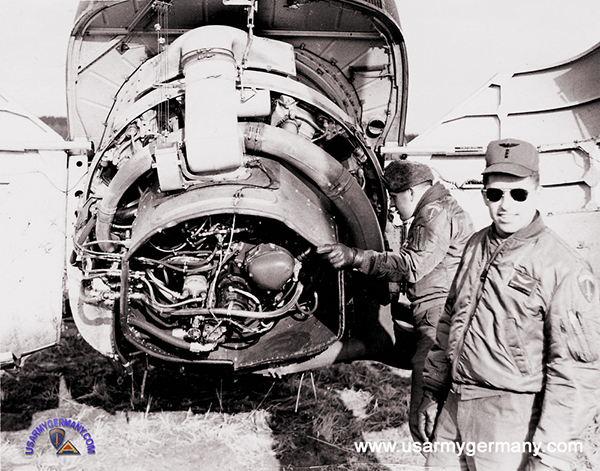 Only have a few pix from those days. Here’s one of Chuck looking at the engine in an H-34 and me looking at the camera (Ed Strazzini) |
||||||||||||||||||||||||||||||||||||||||||||||||||||||||||||||||||||||||
| 1968 | ||||||||||||||||||||||||||||||||||||||||||||||||||||||||||||||||||||||||
| (Source: Email from Ed Strazzini) | ||||||||||||||||||||||||||||||||||||||||||||||||||||||||||||||||||||||||
|
||||||||||||||||||||||||||||||||||||||||||||||||||||||||||||||||||||||||
| I believe our Det Cdr was a Major (Dutch) Schultz but I’m vague on that name as he left us soon after Thanksgiving and was replaced by Cpt William Kegelmeyer. At that time we had 4 warrant officers in the Detachment - CWO Ellsworth (Dusty) Funk, CWO John Niemeyer, CWO Charles Bitely and myself, all recently back from VN tours. Soon thereafter 2 more were assigned to the detachment: CWO Larry Gatlin and CWO Rodney Orton. Two more Captains arrived a few months later: Captain Patrick Neary and another whose name escapes me now. Few of us stayed there very long as the Army’s rotational system for pilots during those days promised no more than 12 months between tours to Vietnam. I left at the end of January 1970 with orders back to SEA after a stop over at Ft Rucker for a CH54 Sky Crane transition. |
||||||||||||||||||||||||||||||||||||||||||||||||||||||||||||||||||||||||
| 370th Engineer Company (CS) | ||||||||||||||||||||||||||||||||||||||||||||||||||||||||||||||||||||||||
| (Source: Email from Everett F. Coppock) | ||||||||||||||||||||||||||||||||||||||||||||||||||||||||||||||||||||||||
| The information on the 370th Engr Co is really lacking. I was assigned twice to the unit -- from 1961 to 1966 and again from 1969 to 1970. In the 1960s we worked our butts off for the other units, keeping the outdated equipment up and running. We went TDY with our equipment and we worked the equipment that other units did not want to operate. The 370th Engr Co (CS) was the best military unit I was in during my 20 years in the Army. Between 1963 and 1965, we had a commander by the name of Donald Summersford, 1st Lt who had a set of (you know what). He did everything he could to make our company up to standards. 1st LT Summersford was, and still is, the best unit commander I ever had while in the Army, bar none. Our 1st SGT, J.C. Rush, was also very good. We had a crew of around 60 E-5's and below. No NCO's. One CWO by name of Oscar Robinson and, boy, did we get along with each other. We worked asphalt plant, concrete batch plant on air bases in Germany and France while other engineer units could not or would not. We did it and with pride! We also supported the US Army training areas all over Europe. If anyone reads this who was stationed with me in Germany, Ft. Leonard Wood or Vietnam, please contact me at weinheimer(at)ev1.net. |
||||||||||||||||||||||||||||||||||||||||||||||||||||||||||||||||||||||||
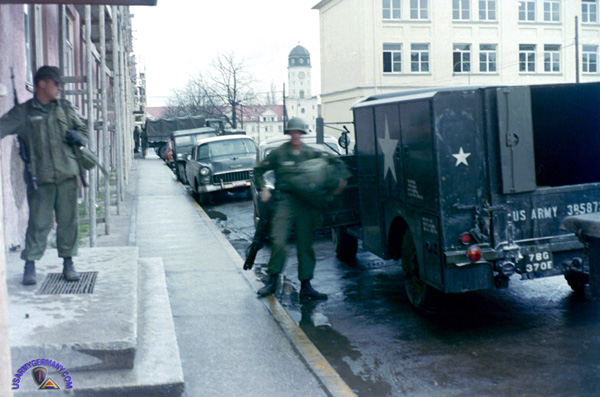 Loading up, Fall of 1965. Alert get-a-way. |
||||||||||||||||||||||||||||||||||||||||||||||||||||||||||||||||||||||||
| (Source: Email from John Buckley, 370th Engr Co (CS), 1965-68) | ||||||||||||||||||||||||||||||||||||||||||||||||||||||||||||||||||||||||
| (Also check out John's Kleber Kaserne pics on the Kaiserslautern Page) I was assigned to the 370th Engr Co (CS) from late in 1965 through early 1968. During my time with the 370th we were a "separate company" attached to US Army Europe Engineer Command and were not part of the 24th Engineer Construction Group. We supported all the Engineering projects through out Germany and did a lot for the Air Force as well, putting down hard stands and run ways. If that wasn't enough, we almost always had a crew involved with "good will" work for the German Nationals. As I recall, a good deal of the time 25 to 60 percent of the company was TDY at one place or another. I remember names such as Bamberg, Baumholder, Bremerhaven (although that was to pick up some redi-mix trucks for the unit), Grafenwoehr, Hanau, Karlsruhe, Pirmasens, Wiesbaden, and Wildflecken from those TDY Orders. The beer of choice was Parkbrau, a local beer. Another thing that has stuck with me are "goulash soup" of which I couldn't get enough. |
||||||||||||||||||||||||||||||||||||||||||||||||||||||||||||||||||||||||
|
||||||||||||||||||||||||||||||||||||||||||||||||||||||||||||||||||||||||
| Related Links: | ||||||||||||||||||||||||||||||||||||||||||||||||||||||||||||||||||||||||
|
||||||||||||||||||||||||||||||||||||||||||||||||||||||||||||||||||||||||
